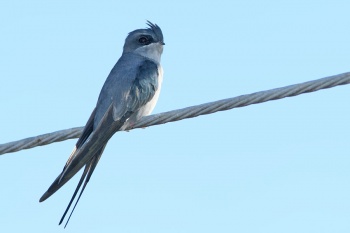(→External Links: Additional GSearch for common name, GSearch checked template) |
|||
| (8 intermediate revisions by 5 users not shown) | |||
| Line 1: | Line 1: | ||
| − | {{ | + | [[Image:Others3.jpg|thumb|400px|right|Male<br />Photo by {{user|Vipul+Ramanuj|Vipul Ramanuj}}.<br />Gir National Park, Gujarat, [[India]], May 2015]] |
| − | ;Hemiprocne coronata | + | ;[[:Category:Hemiprocne|Hemiprocne]] coronata |
| − | |||
==Identification== | ==Identification== | ||
| + | A quite big (23–25 cm; 9-10 in) swift-like bird. | ||
| + | * Grey body, greenish wings | ||
| + | * Grey crest on forehead | ||
| + | * Very long wings which cross over back when perching | ||
| + | * Whitish eyebrow | ||
| + | * Male with red cheeks, female with dark grey cheeks, outlined with white | ||
| + | * Perches upright (like a Swallow, unlike other Swifts) | ||
==Distribution== | ==Distribution== | ||
| + | Southeast [[Asia]]. [[Sri Lanka]], [[India]], [[Bangladesh]], [[Myanmar]], southern [[China]], [[Thailand]], [[Cambodia]] and southern [[Vietnam]]. | ||
| + | |||
| + | Over most of its range only patchily distributed and local but relatively common. Not globally threatened. | ||
==Taxonomy== | ==Taxonomy== | ||
| + | [[Image:IMG 02353.jpg|thumb|350px|right|Female<br />Photo by {{user|Ayuwat+J|Ayuwat J}}<br />Chiang Mai, [[Thailand]]]] | ||
| + | Forms a [[Dictionary_P-S#S|superspecies]] with [[Grey-rumped Treeswift]] ''Hemiprocne longipennis'' and is sometimes considered conspecific. | ||
| + | |||
| + | This is a [[Dictionary_M-O#M|monotypic]] species<sup>[[#References|[1]]]</sup>. | ||
| + | |||
==Habitat== | ==Habitat== | ||
| + | Areas with scattered trees, groves, edges of forest or plantations (eg teak), sometimes semi-evergreen forest. | ||
==Behaviour== | ==Behaviour== | ||
| + | Usually found in pairs or small flocks. | ||
| + | ====Diet==== | ||
| + | Feeds on insects, catched in flight. Perches high on trees. | ||
| + | ====Breeding==== | ||
| + | [[Image:Crested Treeswift3a.jpg|thumb|350px|right|Photo by {{user|Steve+G|Steve G}}<br />[[Yala National Park]], [[Sri Lanka]], July 2007]] | ||
| + | Breeding season differs through range, January to April in India, March to September in Sri Lanka, March to June in Myanmar. Tiny nest on a tree limb with one egg, glued to nest. <br /> | ||
| + | ====Movements==== | ||
| + | Resident, some local movement (eg in the [[Himalayas]]) possible. | ||
| + | ==References== | ||
| + | #{{Ref-Clements6thAug15}} | ||
| + | {{ref}} | ||
==External Links== | ==External Links== | ||
| + | Search the Gallery using the scientific name: | ||
{{GSearch|Hemiprocne+coronata}} | {{GSearch|Hemiprocne+coronata}} | ||
| − | + | <br /> | |
| − | [[Category:Birds]] [[Category: | + | Search the Gallery using the scientific name: |
| + | {{GSearch|"Crested Treeswift"}} | ||
| + | {{GS-checked}} | ||
| + | <br /> | ||
| + | <br /> | ||
| + | |||
| + | [[Category:Birds]] [[Category:Hemiprocne]] | ||
Latest revision as of 20:18, 11 February 2022
- Hemiprocne coronata
Identification
A quite big (23–25 cm; 9-10 in) swift-like bird.
- Grey body, greenish wings
- Grey crest on forehead
- Very long wings which cross over back when perching
- Whitish eyebrow
- Male with red cheeks, female with dark grey cheeks, outlined with white
- Perches upright (like a Swallow, unlike other Swifts)
Distribution
Southeast Asia. Sri Lanka, India, Bangladesh, Myanmar, southern China, Thailand, Cambodia and southern Vietnam.
Over most of its range only patchily distributed and local but relatively common. Not globally threatened.
Taxonomy
Forms a superspecies with Grey-rumped Treeswift Hemiprocne longipennis and is sometimes considered conspecific.
This is a monotypic species[1].
Habitat
Areas with scattered trees, groves, edges of forest or plantations (eg teak), sometimes semi-evergreen forest.
Behaviour
Usually found in pairs or small flocks.
Diet
Feeds on insects, catched in flight. Perches high on trees.
Breeding
Breeding season differs through range, January to April in India, March to September in Sri Lanka, March to June in Myanmar. Tiny nest on a tree limb with one egg, glued to nest.
Movements
Resident, some local movement (eg in the Himalayas) possible.
References
- Clements, J. F., T. S. Schulenberg, M. J. Iliff, D. Roberson, T. A. Fredericks, B. L. Sullivan, and C. L. Wood. 2015. The eBird/Clements checklist of birds of the world: v2015, with updates to August 2015. Downloaded from http://www.birds.cornell.edu/clementschecklist/download/
Recommended Citation
- BirdForum Opus contributors. (2024) Crested Treeswift. In: BirdForum, the forum for wild birds and birding. Retrieved 1 November 2024 from https://www.birdforum.net/opus/Crested_Treeswift
External Links
Search the Gallery using the scientific name:
Search the Gallery using the scientific name:
GSearch checked for 2020 platform.






